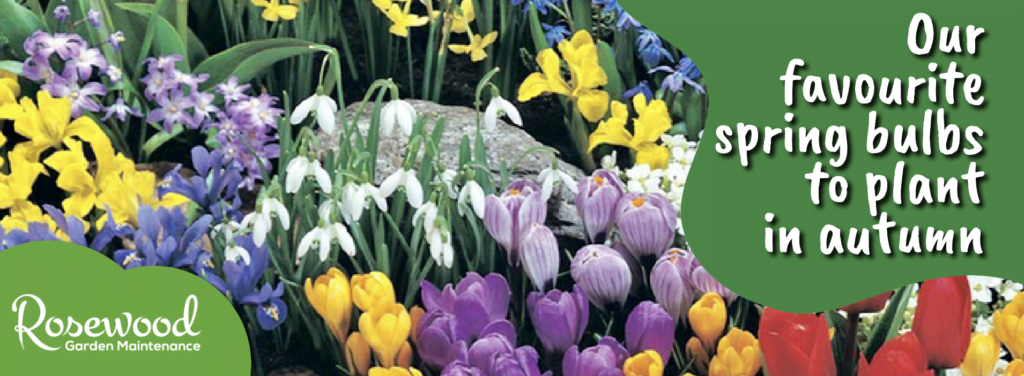
Nothing lights up the garden and welcomes in the new season like beautiful spring bulbs. They provide a burst of colour before most perennials, trees and shrubs have got going and mark the start of longer, brighter days. With a small bit of planning, you can enjoy colour from bulbs from February right up until May.
Why do we plant spring bulbs in Autumn?
Spring flowering bulbs are best planted in autumn as the soil is still warm from the summer sun. (if we’re lucky, that is!) This means that they can develop their root system quietly underground before appearing at the start of the spring.
Spring bulbs can be planted directly into borders and most grow very well in pots, making them perfect for patios and smaller gardens. As a general rule, bulbs need to be planted at a depth of around three times their size.
We recommend planting as many spring bulbs as you can afford or have room for, they really do look better in abundance! Some will happily naturalise in undisturbed areas under trees or lawns, creating a natural-looking carpet of colour.

How to care for spring bulbs
Most spring bulbs are perennial and will come up year after year if the conditions are right (tulips being the exception, while some may flower for a few years, they’re best topped up every autumn for the best display). Always allow the foliage to die back completely before removing it, as this feeds next year’s bulbs.
If you’re growing bulbs in pots, give them a liquid feed after flowering to help feed next year’s bulbs, and store the pot somewhere cool over summer. Alternatively, dig the bulbs up after flowering and replant them in the garden. Let’s take a look at some bulbs to plant.
Snowdrops
Snowdrops (Galanthus nivalis) are the first bulbs to flower, usually in February, and are known as the typical first sign of spring. They flower whatever the weather – even in the snow! Grow in moist, well-drained soil in partial shade. They look particularly good under shrubs and trees. Snowdrops can also be grown in pots.


Winter Aconites
The cheerful yellow flowers of winter aconite (Eranthis hyemalis) are a welcome sight in early February. They look best grown in large quantities in a natural setting, under deciduous trees or shrubs, and combine beautifully with snowdrops. They can be tricky to establish but once settled they will spread naturally. Ideally, grow in a spot that is sunny in winter but shaded in summer, as aconites will not thrive in dry soil.


Reticulate iris
Iris reticulata are fabulous bulbs for small pots, window boxes and raised beds, plus other sunny and free-draining spots in the garden. They bring much-needed colour in February and March, and their mostly blue and purple flowers have beautiful, intricate markings. They are extremely popular with early bees, as their purple shade attracts all kinds of important pollinators. If you’re interested in other pollinator-friendly flowers, read our blog on how to grow a pollinator- friendly garden.
Crocus
Carpets of small purple, yellow and white crocus flowers are a highlight in the garden from late winter onwards. They also provide a much-needed source of nectar and pollen for pollinating insects just emerging from hibernation. Crocuses are easy to grow and are well-suited to growing in pots or at the front of borders and naturalising in grass. They really like sunny spots!


Daffodils
Daffodils (Narcissus) brighten our gardens throughout spring. There are many different varieties, some flowering as early as February and others as late as early May. Daffodils range in height from about 10cm up to 45cm and come in a variety of colours and forms. In addition to the usual yellow, flowers can be white, cream or lemon, with trumpets of contrasting shades. Some are beautifully scented. Daffodils grow brilliantly in pots and look great in borders.
Alliums
Alliums flower in May and June, bridging the gap between spring and summer perfectly. Loved by bees and other pollinators alike, the beautiful pom pom flowers on tall stems come mostly in shades of purple, but also pink and white. They look fantastic threaded through a border! Grow as many as you can for the most stunning effect. Alliums like to grow in moist but well-drained soil in full sun.


Spring bulb top tips
- You can buy spring bulbs readily available in any garden centre, although there is usually a wider selection online. A lot of established centres offer readily selected collections with an array of different bulbs that complement each other.
- Steer clear of the bulbs that have become soft or shrivelled, and instead opt for strong, solid bulbs.
- Store your bulbs in a cool, dry place out of direct sunlight until you are ready to plant. Try to plant your bulbs within a few weeks or else you run the risk of them sprouting.
- Spring bulbs generally need sun or partial shade and free-draining soil, so if you know your soil is very heavy, it might be best to incorporate some horticultural grit when planting.
Garden maintenance services
If your garden requires a little TLC before the winter sets in, or you need a helping hand planting some bulbs ready for spring, then please get in touch with the team here at Rosewood. Now is a great time to strip your garden back and give it a good tidy up in preparation for the colder months ahead. Our team will do the hard work (most likely in the trusty British weather) so you don’t have to!
Give us a call on 07393 821797, or follow us on Facebook or Instagram to see what our busy team are up to.






